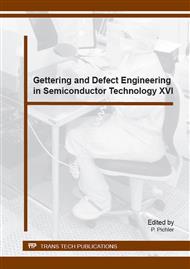[1]
R.S. Bonilla, F. Woodcock, P.R. Wilshaw, Very low surface recombination velocity in n-type c-Si using extrinsic field effect passivation, J. Appl. Phys. 116 (2014) 054102.
DOI: 10.1063/1.4892099
Google Scholar
[2]
A.G. Aberle, S. Glunz, W. Warta, Impact of illumination level and oxide parameters on Shockley-Read-Hall recombination at the Si-SiO2 interface, J. Appl. Phys. 71 (1992) 4422–4431.
DOI: 10.1063/1.350782
Google Scholar
[3]
A. Aberle, S. Glunz, W. Warta, Field effect passivation of high efficiency silicon solar cells, Sol. Energy Mater. Sol. Cells. 29 (1993) 175–182. http: /dx. doi. org/10. 1016/0927-0248(93)90075-E (accessed August 1, 2012).
DOI: 10.1016/0927-0248(93)90075-e
Google Scholar
[4]
S.W. Glunz, D. Biro, S. Rein, W. Warta, Field-effect passivation of the SiO2 Si interface, J. Appl. Phys. 86 (1999) 683–691. doi: 10. 1063/1. 370784.
DOI: 10.1063/1.370784
Google Scholar
[5]
V. Leonov, P. Fiorini, C. Van Hoof, Stabilization of positive charge in SiO2/Si3N4 electrets, IEEE Trans. Dielectr. Electr. Insul. 13 (2006) 1049–1056. doi: 10. 1109/TDEI. 2006. 247831.
DOI: 10.1109/tdei.2006.247831
Google Scholar
[6]
S. Dauwe, J. Schmidt, A. Metz, R. Hezel, Fixed charge density in silicon nitride films on crystalline silicon surfaces under illumination, in: Conf. Rec. Twenty-Ninth IEEE Photovolt. Spec. Conf. 2002., IEEE, n. d.: p.162.
DOI: 10.1109/pvsc.2002.1190481
Google Scholar
[7]
I. Martin, B. Hoex, M.C.M. van de Sanden, R. Alcubilla, W.M.M. Kessels, The origin of emitter-like recombination for inverted c-Si surfaces, in: 23rd Eur. Photovolt. Sol. Energy Conf., Valencia, Spain, n. d. http: /www. tue. nl/en/publication/ep/p/d/ep-uid/238107/?no_cache=1 (accessed January 18, 2013).
Google Scholar
[8]
F. -J. Ma, G.G. Samudra, M. Peters, A.G. Aberle, F. Werner, J. Schmidt, et al., Advanced modeling of the effective minority carrier lifetime of passivated crystalline silicon wafers, J. Appl. Phys. 112 (2012) 054508. doi: 10. 1063/1. 4749572.
DOI: 10.1063/1.4749572
Google Scholar
[9]
S. Steingrube, P.P. Altermatt, D.S. Steingrube, J. Schmidt, R. Brendel, Interpretation of recombination at c-Si/SiN[sub x] interfaces by surface damage, J. Appl. Phys. 108 (2010) 014506. doi: 10. 1063/1. 3437643.
DOI: 10.1063/1.3437643
Google Scholar
[10]
B. Veith, T. Ohrdes, F. Werner, R. Brendel, P. Altermatt, N. -P. Harder, et al., Injection dependence of the effective lifetime of n-type Si passivated by Al2O3 : an edge effect?, in: Proc. SiliconPV 2013 - Solomat, n. d.: pp. Hamelin, Germany.
DOI: 10.1016/j.solmat.2013.06.049
Google Scholar
[11]
R.A. Sinton, A. Cuevas, M. Stuckings, Quasi-steady-state photoconductance, a new method for solar cell material and device characterization, in: Photovolt. Spec. Conf. 1996., Conf. Rec. Twenty Fifth IEEE, 1996: p.457.
DOI: 10.1109/pvsc.1996.564042
Google Scholar
[12]
I.D. Baikie, S. Mackenzie, P.J.Z. Estrup, J.A. Meyer, Noise and the Kelvin method, Rev. Sci. Instrum. 62 (1991) 1326–1332. doi: 10. 1063/1. 1142494.
DOI: 10.1063/1.1142494
Google Scholar
[13]
R.S. Bonilla, P.R. Wilshaw, Stable field effect surface passivation of n-type Cz silicon, in: Energy Procedia - Proc. 3rd Silicon PV Conf., Elsevier, Hamelin, Germany, 2013: p.816–822. doi: 10. 1016/j. egypro. 2013. 07. 351.
DOI: 10.1016/j.egypro.2013.07.351
Google Scholar
[14]
Z. Hameiri, F. -J. Ma, K.R. McIntosh, Investigation of low injection effects using the local ideality factor obtained from effective lifetime measurements, in: 2014 IEEE 40th Photovolt. Spec. Conf., IEEE, 2014: p.1842.
DOI: 10.1109/pvsc.2014.6925282
Google Scholar
[15]
F. -J. Ma, Z. Hameiri, G.S. Samudra, M. Peters, B. Hoex, Numerical analysis of injection level dependent effective lifetime on 125 mm undiffused lifetime samples, in: 2014 IEEE 40th Photovolt. Spec. Conf., IEEE, 2014: p.3313.
DOI: 10.1109/pvsc.2014.6925643
Google Scholar
[16]
A. Richter, S.W. Glunz, F. Werner, J. Schmidt, A. Cuevas, Improved quantitative description of Auger recombination in crystalline silicon, Phys. Rev. B. 86 (2012) 165202. doi: 10. 1103/PhysRevB. 86. 165202.
DOI: 10.1103/physrevb.86.165202
Google Scholar
[17]
K. McIntosh, M. Abbott, PV LightHouse Mobility Calculator, (2015). www. pvlighthouse. com. au.
Google Scholar
[18]
D.B.M. Klaassen, A unified mobility model for device simulation—II. Temperature dependence of carrier mobility and lifetime, Solid. State. Electron. 35 (1992) 961–967. doi: 10. 1016/0038-1101(92)90326-8.
DOI: 10.1016/0038-1101(92)90326-8
Google Scholar
[19]
K.L. Luke, L. -J. Cheng, Analysis of the interaction of a laser pulse with a silicon wafer: Determination of bulk lifetime and surface recombination velocity, J. Appl. Phys. 61 (1987).
DOI: 10.1063/1.337938
Google Scholar


